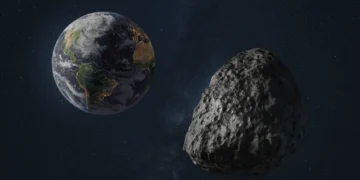Asteroids have always fascinated scientists and stargazers alike, but when one is dubbed “God of Chaos,” it grabs everyone’s attention. Recently, the asteroid 99942 Apophis, often referred to as the “God of Chaos,” has re-entered the spotlight with new research suggesting that its trajectory could potentially be altered, posing a renewed risk of collision with Earth. let’s explore the recent developments, the science behind these findings, and why it is crucial to keep an eye on space rocks like Apophis.
Understanding Apophis and Its Threat
Discovered in 2004, asteroid 99942 Apophis is one of the most well-known near-Earth objects (NEOs). With a size of approximately 1,100 feet (335 meters) across, it was initially given a 2.7% chance of impacting Earth in 2029. However, subsequent observations ruled out this scenario, providing relief to both scientists and the public. Apophis was predicted to pass safely at a distance of about 18,300 miles (29,470 kilometers) from Earth—close enough to be seen with the naked eye but not close enough to pose a threat.
Recent findings by Canadian astronomer Paul Wiegert have reignited concerns. Wiegert’s study suggests that Apophis’s trajectory could be altered by a collision with a smaller asteroid or space debris. While the probability of such an event causing Apophis to impact Earth is extremely low—estimated to be less than one in two billion—it is not zero. This possibility has prompted scientists to re-evaluate the potential risks and the importance of monitoring near-Earth objects more closely.
The Science Behind Trajectory Changes
Asteroids like Apophis move through space following predictable paths influenced by gravitational forces from the Sun and planets. However, space is not a vacuum; it is filled with other objects, both large and small, that can potentially alter these paths. According to Wiegert’s research, a collision with a smaller object—just a few meters in size—could impart enough force to change Apophis’s trajectory slightly. If such a collision were to occur, the asteroid’s velocity could change by a few centimeters per second—enough to potentially redirect it toward Earth.
To understand this concept, it is essential to consider the vast distances and speeds involved in space. A small nudge might seem insignificant, but over millions of miles and several years, it can result in a significant deviation from the original path. The current calculations suggest that for Apophis to be redirected toward Earth, the change in velocity would need to exceed 5 × 10^−2 meters per second. While the odds are incredibly slim, this scenario underscores the unpredictability of space and the need for constant vigilance.
Implications for Planetary Defense
The renewed concern over Apophis brings to light the broader issue of planetary defense. The asteroid has been largely unmonitored since 2021 and will remain so through 2027 due to its current position relative to Earth and the Sun. This period of observational blackout raises concerns about the accuracy of our predictions and the importance of maintaining continuous monitoring of potentially hazardous asteroids (PHAs).
The threat from Apophis, however minuscule, demonstrates the need for robust planetary defense mechanisms. Organizations like NASA and the European Space Agency (ESA) have been developing strategies to detect and, if necessary, deflect asteroids that could pose a threat to Earth. For instance, NASA’s Double Asteroid Redirection Test (DART) mission, launched in 2021, successfully demonstrated the potential to alter an asteroid’s trajectory by deliberately crashing a spacecraft into it. This kind of active intervention could become a critical tool in our planetary defense arsenal.
In addition to direct action, enhancing our observation capabilities is vital. New telescopes, both ground-based and space-based, can provide earlier and more accurate detection of objects like Apophis. Continuous monitoring ensures that any changes in an asteroid’s trajectory, due to factors like collisions with smaller objects, are detected in time to take necessary action.
Public Awareness and Scientific Communication
While the possibility of Apophis hitting Earth is exceedingly low, the importance of public awareness and scientific communication cannot be overstated. Historically, the discovery of potentially hazardous asteroids has often been accompanied by sensational headlines, which can cause undue panic. It is essential for scientific communities and space agencies to communicate findings clearly and effectively, providing context about the actual risks involved.
By understanding the science behind asteroid dynamics and the factors that can alter their courses, the public can appreciate the efforts being made to keep our planet safe. Moreover, engaging the public in conversations about space and planetary defense can foster a more science-literate society that supports ongoing research and development in this field.
Conclusion
The new findings regarding the “God of Chaos” asteroid Apophis serve as a reminder of the dynamic nature of our universe and the ever-present need for vigilance. Although the likelihood of a catastrophic impact remains incredibly low, the potential for even a slight change in trajectory underscores the importance of continued monitoring and preparedness. As we advance our capabilities to observe and, if necessary, intervene, we move closer to ensuring that our planet remains safe from the myriad threats lurking in the vast expanse of space.
By understanding these threats and the science behind them, we can better appreciate the importance of planetary defense strategies and the continuous efforts of scientists worldwide to safeguard our future.



















